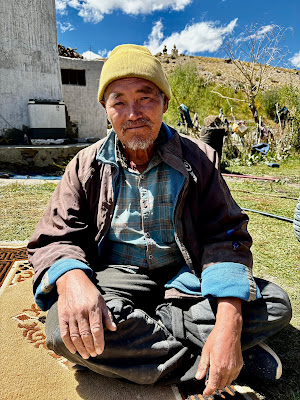In Zanskar, Sonam used the wood from Paddar for repairing old buildings and roofing new ones, while selling the Khems to Balti traders entering Zanskar from Pensila. Khems purchased in Paddar for Rs 5 were sold for Rs 10 to the Baltis. The Baltis, numbering around 14-15, traveled throughout Zanskar to Padum, selling horses, rice, chickens, and cattle. They also came from Damna, Kashmir, through the Chilong Valley near Panikhar, bringing cows to exchange for sheep and money. They were followed by Shamma traders from Tingmosgang, Nurla, and other places in the Sham region, who brought 30-35 donkeys loaded with kerosene in jerrycans. The Shamma traders would charge separately for the empty jerrycans.
Changpa Salt traders
During the 8th or 9th month of the Ladakhi calendar, the Changpas would visit Zanskar. Sonam vividly remembers the arrival of the Changpas. They would set up in a large field at the edge of the village and begin an age-old tradition of killing a big male sheep, Khalpa, presenting the meat to every family as a gift and announcement of their arrival. Only after this ritual would the Changpas start selling salt to the Zanskaris. The exchange rate was one Lugal (a bag used to load salt on sheep) of salt for an equal quantity of barley, whereas in central Zanskar, the rate was double—half a Lugal of salt for a full Lugal of barley.
For the Changpas entering Ladakh from the Zunglam crossing the Chacharla and from Lingti River crossing the Chumik Marpo, Akshow was the last point in Zanskar. For the Baltis entering from the west side, Padum was the last point where their goods would be sold. A popular saying in Zanskar reflects this: Akshow and Abran is the place for distress sales for the Changpas, while Padum is the place for distress sales for the Baltis.
Zanskari Horses
Sonam also notes that, until a decade ago, horses were a crucial part of Zanskari life. Every family in Akshow owned 2-3 horses, but now only his and his brother's families have horses. Zanskari and Spiti horses were highly valued, with Spiti horses being particularly prized. People from Akshow would travel with their horses to Kargil and return in 25 days with rice, salt, marnak, samar (kerosene oil), and pakpey (wheat flour). Sonam traveled on horseback to Sankoo to buy sarnak, samar, das (rice), and pakpey for the winter. Fifty years ago, a winter purchase of Mul 100 (Rs 100) was considered very good. The best Zanskari horses, known as Yorga, were prized for their smooth ride. Sonam’s brother recently sold a two-year-old Yorga for Rs 50,000 to a Kashmiri from Warwan. Yorga horses are now scarce in Zanskar, and the tradition of training horses to improve their gait has nearly vanished. According to Aba, traditionally, the best horses in Zanskar came from the Yulsum area near Karsha Gompa. Friends from Yulsum would graze their horses in the Stod region near Akshow due to its superior grazing grounds.
Zanskari Butter
The Stod region of Zanskar, is renowned for its high-quality Zanskari butter. It is believed that it owes its special taste to a variety of herbs in the region that the cattle feed on. According to Sonam, the best butter comes from dzomo (a mix of yak and domestic cattle). A dzomo yields about 1.5 to 2 liters of milk per day. Producing one liter of Zanskari butter requires about 10 liters of dzomo milk. In the past, Shamma traders visiting Zanskar to sell kerosene would exchange a jerrycan of kerosene for 3 kilos of butter. The money value of butter was Rs 33 per batti (2 kilos). Sonam’s father had a Shamma trader friend who would buy their butter for Rs 37 per batti. With the proceeds, Sonam would go to Kargil to buy food items.


No comments:
Post a Comment